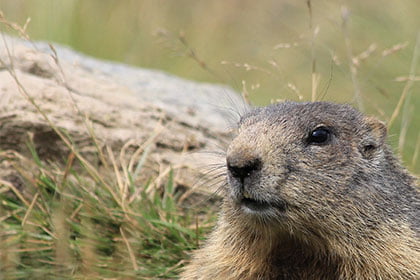Every year, on Groundhog Day, Quebecers rely on Fred (a marmot from the Gaspé) to predict the arrival of spring. Do you remember the date of this event? See if you can find the right answer among these options…
a ) January 15
b ) February 2
c ) February 27
d ) March 4
Do you think you have the right answer? If you chose option “b”, congratulations! However, we are quite sure that you will learn many things from this article.
By the way, in anticipation of February 2nd, we have decided to provide you with 5 amazing facts about marmots, also known as “whistlers” in Quebec.
On your marks, get set, go!
The marmots eat their excrement.
Yes, you read that right. Marmots eat their excrement, because they are caecotrophic. Doesn’t that word mean much to you? We will explain it! In fact, caecotrophic animals, like marmots, need to digest their food twice in order to assimilate their nutrients. After the first passage of a food through the digestive tract, caecotrophs (a word that also refers to the excrement of caecotrophic animals – yes, it is mixing) are produced. These soft droppings are then consumed in turn, and the end result is small hard droppings. It’s fascinating, isn’t it?
Marmots are related to squirrels.
Indeed, marmots and squirrels are all members of the sciuridae family, i.e. rodents that can cast shade with their tails. If you missed our article on squirrels, we encourage you to check it out!
The marmots are hibernating.
The expression “sleeping like a marmot” did not appear by chance, because marmots actually sleep for five and a half months each year. To survive the winter, these burrowing mammals eat heavily in the fall, creating a layer of fat under their fur. In addition, during the hibernation period, the heart rate of marmots slows down to about 5 beats per minute and their body temperature drops. Thanks to this, marmots do not run out of fat reserves before the end of hibernation.
And what about their natural needs? During this period, it is only about once a month that the marmots wake up to take care of them! What a luxury!
The nickname “whistling” comes from the shrill sound that marmots make.
Whistlers don’t whistle often, but when they do, it’s to warn their peers of potential danger. Check out this video to hear the whistle of a marmot! You’ll see, it’s surprising!
Groundhogs will probably leave your yard alone if you put in a scarecrow or an automatic watering system.
If you have an unwanted visitor in your garden, don’t hesitate to scare him by installing a scarecrow or a watering system that starts automatically with a motion detector. It’s harmless, but effective!
What if it doesn’t work? Call Brisebois Extermination, and we will help you.
So Fred and his friends will leave you alone, and you’ll finally be able to sleep like a woodchuck, too…

